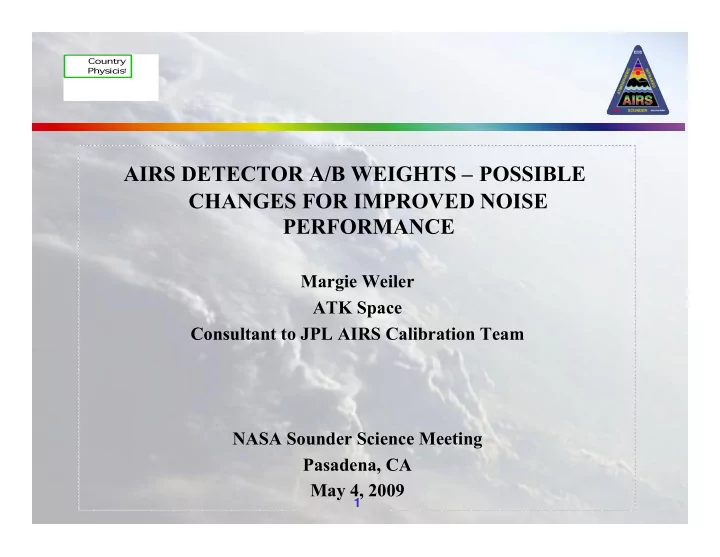

AIRS DETECTOR A/B WEIGHTS – POSSIBLE CHANGES FOR IMPROVED NOISE PERFORMANCE Margie Weiler ATK Space Consultant to JPL AIRS Calibration Team NASA Sounder Science Meeting Pasadena, CA May 4, 2009 1
AIRS DETECTOR A/B WEIGHTS - UPDATE Background on degradation in channel noise properties for a very • small fraction of the AIRS channels – Probably due to radiation effects Finding which of the 2 redundant detectors has degraded (A or B) • Channels with “cold scene noise” also considered • Criteria for selecting channels for weight changes • – The intention is to increase the reliability of the data for climate monitoring with little or no impact on weather forecasting Summary of channel counts • Preliminary list of channels for which weight changes are • proposed Additional data from “OBC Stare” tests • Discussion • 2
CHANNEL DEGRADATION The vast majority of the AIRS 2378 IR channels continue to have excellent • performance A small number of channels have exhibited a large increase in noise after • radiation hits (in the SAA or near the poles); a few others have shown increased and/or variable noise, probably due to an accumulation of total radiation dose 3
“NOISY CHANNELS” LISTS Lists of “noisy” channels have been distributed periodically • in recent years These channels were previously expected to have acceptable • noise (in “good” states) but have had large numbers of high noise and/or pop flags (over 10 granules flagged per day) The total number of channels ever listed is 121 (out of 2378) • Of these, 22 have recovered to acceptable noise levels and 26 • more have noise levels that are higher than before but still acceptable Some of the 73 remaining degraded channels could be • “rescued” by changing detector weight, for example if only the A detector had degraded for a channel with A=B weight 4
IDENTIFICATION OF DEGRADED DETECTORS (A or B) Guard tests are run about every month during spacecraft lunar • roll maneuvers, during which a few minutes of L0 data are collected after A-only, B-only, and A/B Opt (operational) gain tables are loaded in sequence From the data the gain and NEdT are calculated • For degraded channels, the NEdT data were examined to identify • the detector involved 5
COLD SCENE NOISE Some channels have • occasionally shown large bursts of noise when viewing cold scenes, primarily during space looks A “cold scene noise” flag was • developed to detect these events – This is included in the high noise flag instead of being a separate flag Some channels exhibit these • bursts frequently, detectable in plots of the NEdT daily maximum values 6
COLD SCENE NOISE, cont’d A clear signature of cold scene noise is a large number of very • high daily maximum NEdT values compared to the daily mean In some cases the Guard Test data indicates that one of the two • detectors may be the unreliable one 7
CRITERIA FOR WEIGHT CHANGE Of the 121 channels originally investigated, 22 appeared to have recovered • An early list was distributed proposing 55 channels for weight changes; however it • was suggested in response that only “essentially useless” channels should be included – For about 26 channels, a simple change in nominal NeN values should eliminate the frequent high noise flags, i.e. the channel noise is higher than before but still acceptable The revised criterion is that the channel should have noise issues severe enough to • compromise the OBC/space look calibration – NEdT > 1K – Very frequent occurrences of invalid NEdT from the PGE – Really extreme cases of cold scene noise For 36 channels, the alternative detector was very noisy • This leaves 37 channels for which weight changes are being recommended • – A revised preliminary summary spreadsheet of their properties has been distributed 8
SUMMARY OF CHANNEL COUNTS Number of AIRS channels: 2378 Number in “poor” states: 176 Number in “good” states: 2202 Of these, total number of channels with degradations noted: 121 Channels “recovered”: 22 Channels needing new limits (otherwise noise OK): 26 Channels without alternative detector: 36 Channels for which new weights are recommended: 37 9
PRELIMINARY LIST OF CHANGES 10
OBC STARE TESTS Additional data are being collected during the current series of • orbital adjustment maneuvers, during which the scan mirror is parked staring at the OBC – The data are similar to the C7 Space View Noise test data except for the short wavelength modules where the high scene temperature affects the measured noise – These data will be combined with the most recent C2 Guard Test data, using the “A/B opt” data analysis scripts, to produce a new set of recommended channel States These data will be assessed in comparison with the other data • before a final list of weight changes is approved 11
DISCUSSION The noise performance and calibration reliability of a small • number of AIRS channels can be improved by changing the detector weights for those channels The changes are strongly recommended but subject to input from • the user community The changes are probably too small to affect weather forecasting • An issue is the potential loss of continuity of the data for climate • monitoring – A change in channel weight can result in a small change in the spectral centroid (less than about 0.5 µ m) [Strow et al., IEEE Trans. on Geoscience and Remote Sensing 41, 279 (2003)] A program could be supplied to make the small corrections to • convert the radiances to those expected from the original weights (similar to the L1C spectral shift process) 12
Recommend
More recommend